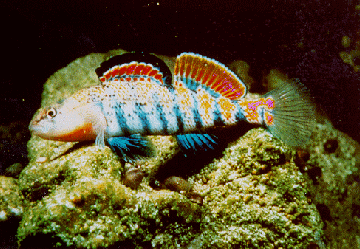Classification

Domain: Eukarya
Kingdom: Animalia
Phylum: Chordata
Class: Actinopterygii
Order: Perciformes
Family: Percidae
Genus: Etheostoma
Species: Etheostoma caeruleum
Domain: Eukarya
Eukaryotic organisms are unique when compared with
the Archaea and Bacteria domains because their cells contain a nucleus
that holds important genetic material. These Eukaryotic cells are
membrane-bound and can create other multi-cellular organisms. In
contrast, both Archaea and Bacterial organisms are prokaryotic, meaning
they do not have a nucleus or any organelles bound by a membrane.
Kingdom: Animalia
The kingdom Animalia consists of organisms that
mainly receive their energy from other animals by feeding on them as
predators. This is opposite of most plant species because they often
create their own food through photosynthesis. The cells of these animals
do lack a cell wall and vary in other ways when compared to different
kingdoms. Since this category is extremely broad, it is hard to
distinguish with a multitude of characteristics (Encyclopedia of Life,
2011).
Phylum: Chordata
The phylum Chordata consists of many popular
vertebrates such as mammals, birds, reptiles, amphibians and fishes.
Their bodies are all bilaterally symmetrical and can be separated into
head, trunk and tail. Members of the Chordata phylum also have a
notochord (a cartilaginous skeletal rod), a nervous system and visceral
clefts and arches (Encyclopedia of Life, 2011).
Class: Actinopterygii
This class makes up half of all living vertebrates
and is considered the largest and most successful group of fishes. Most
of the members of this group have webs of skin to serve as their fins
with bony or horny spikes as a support system. Actinopterygii are found
in every aquatic habitat and often times serve as a food source for the
human population (Encyclopedia of Life, 2011).
Order: Perciformes
Perciformes can be considered one of the most
popular vertebrate groups living in the oceans today and is the biggest
order among all of the fish. They actually vary widely when it comes to
things such as color, size, shape and feeding, migration and breeding
behaviors. However, all Perciformes do have similar fins in addition to
a unique jaw that sucks food in for nutritional purposes (Encyclopedia
of Life, 2011).
Family: Percidae
The fish in this family have both soft rays and
stiff spines that make up their fins. The dorsal fin of Percidae is
divided into two sections and is located on the middle back; the front
is spiny, whereas the rear is soft rayed. These fish can easily by
distinguished between others because of its lack of an adipose fin
(Inland fishes of New York, 2006).
Genus: Etheostoma
Etheostoma represents around one hundred
species of darter fish. All of these darters are native to North America
and live mainly in clear streams, towards the bottom of the water. They
dart around quickly to capture their prey and eat many types of small
aquatic animals. Additionally, all members of the genus Etheostoma, have
two dorsal fins and are usually between five and seven centimeters
(Encyclopedia Britannica, 2013).
Species: Etheostoma caeruleum
Etheostoma caeruleum, or the rainbow
darter, are a species of fish that live mainly in clear-water streams.
They are somewhat colorful, but reach their highest variance in color
during mating season (Lyons, 1999). The rainbow darter also has six to
ten stripes saddled down the side of their body with fourteen running
vertically. These fish usually live up to four years and produce between
three to seven eggs during one reproduction cycle (Marko and Fink).
Next, read about the habitat of the rainbow darter, or return to the home page.